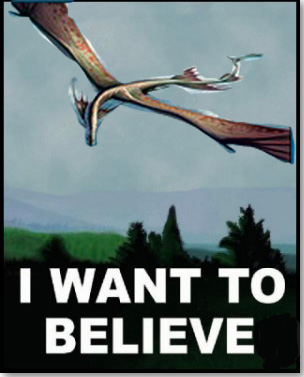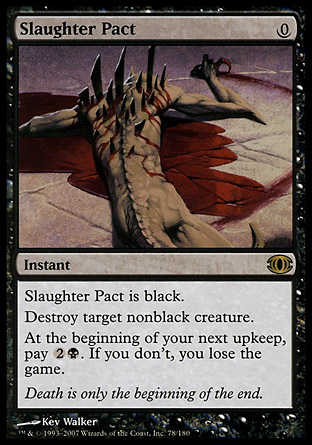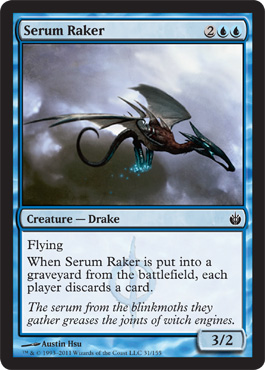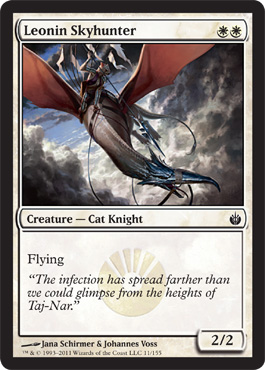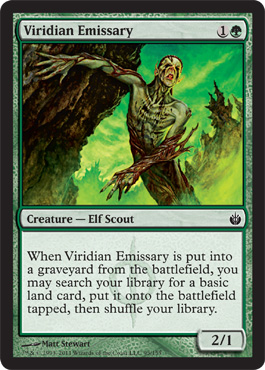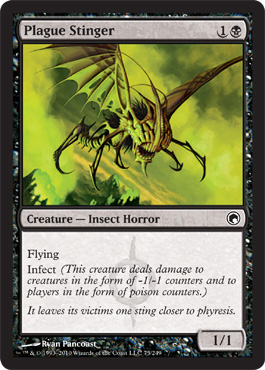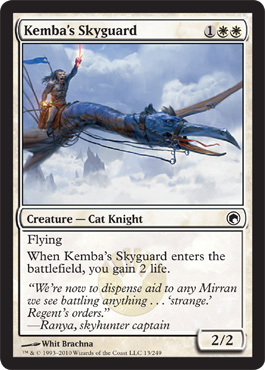Archive
Skywinder Drake
Tom LaPille is my hero. While I will certainly admit there’s substantial fanboy influence happening here, he actually created something amazing: he was the lead developer for Magic 2012.
That means he’s the man who signed off on including Skywinder Drake in set the final product.
(To be clear, it was the design team that put Cloud Spirit in, and the creative team that adapted it into it’s Drake form. My gratitude goes to those all of team members and the rest of the developers too, but my fanboy-ism still needs rationalizing.)
You’ll be hard-pressed to find a bigger fan of Cloud Spirit and Rishadan Airship than me, and our new Drake will be the first piece of redundancy to hit “three copies” in my cube.
Perhaps I’m warming up to blue again after all.
If It Flies, It Dies
Skywinder Drake, like it’s two brothers in crime, provides blue a much needed piece of aggression at common. I won’t rehash the “add blue aggro to your cube” argument, but when you’re dealing with just commons it moves beyond a modest suggestion.
Calcite Snapper and Giant Tortoise have their place, and they serve very valuable purposes too. The issue is that those kinds of creatures are just one half of the team. Blocking the ground while pounding in the sky is a classic Limited strategy, and it’s one that, I’m happy to share, is alive and well in my cube. More importantly, getting both the offense and defense online quickly makes this most effective.
I may or may not have once played a sequence of turns as follows:
- Island, Preordain
- Island, Giant Tortoise
- Mountain, Cloud Spirit
- Mountain, Searing Blaze, Miscalculation their 3- or 4-drop
- Island, sac tapped Island to kick Rushing River, Counterspell their relevant play
- Mountain, kicked Pouncing Kavu, opponent is at 5
Skywinder Drake is a simple but effective bump in the aggressive power of blue. I don’t believe the “3/3 with flying for five mana” guys are leaving anytime soon, but smacking in for six damage, forcing an opponent burn a kill spell to deal with that guy, before dropping the five mana dudes seems fine. In fact, that order of events seems much more appealing than the other way around.
While it may feel odd to have something that can’t block as an early drop in blue, it’s the attachment to “blue is control” mentality holding you back. Pauper doesn’t have Control Magic and other permanent “steal” effects. Pauper doesn’t have effective duplication of Wrath of God board-clearing effects. Under almost any circumstance, to win in pauper cubes you have to attack. Blue has to have ways to attack efficiently.
If it can be done in cube despite Control Magic and friends, it’s a breeze to bash in pauper.
Believe in the Drake (or Airship, or Spirit). It’ll get in there.
(“Poster” courtesy of Dan Tack.)
Carnivorous Death-Parrot
I know what you’re probably thinking: “Not another one of Adam’s soft sells for Un–Magic. He’s going to point out a card that effectively exists in normal Magic but comes with a little wacky flavor of the Un side.”
Not today. Shocking, I know.
Lies, Damn Lies, Stybs-isms
First, what kooky card are we looking at exactly?
Carnivorous Death-Parrot is a clever twist on a steep drawback for an efficient blue creature. The “steep drawback” here is having to say the flavor text, cleverly written to trigger several powerful gotcha cards, like Deal Damage and Creature Guy. This means in Unhinged Limited, this guy is both efficient and very risky.
Obviously, the circumstances change dramatically outside of that environment. There are no gotcha cards in my pauper cube, and the relevant ones are uncommons anyway. That said, does removing the risk associated with “paying the upkeep trigger” warrant removing the trigger altogether? I don’t believe so as this guy would then be better than something like Leonin Skyhunter.
I believe that in bringing this guy into “normal” Magic, we can reach a clean decision on how to deal with the upkeep trigger in one of two ways:
- Ignore it (the option that doesn’t make sense)
- Adopt some sort of “Pay 0 or this is sacrificed.” errata.
As I’d already ruled out the first option, I settled on this errata:
At the beginning of your upkeep, you may pay 0. If you don’t, sacrifice Carnivorous Death Parrot.
I will always personally say the flavor text, and most other players who run into it will as well. However, the upkeep trigger stated here is the effective equivalent: if you don’t pay an optional cost of nothing you lose the creature.
“I thought you weren’t trying to sell us on adapting Un cards!” I’m really not. If you’ve played a more traditional cube you may have run into something like this:
You play it then have to pay an upkeep trigger. Recalling a singular upkeep trigger is a less mentally taxing than a continuous one (although the Pact cycle comes with a much steeper clause in the event that you can’t pay it).
Our Bird isn’t so generous, and playing it requires the mental effort to always pay for the trigger. It’s certainly more demoralizing to straight up lose the game for being a little forgetful, but the oddity of having an upkeep cost of 0 is enough to make our bloody parrot the more difficult one to remember.
That said, this guy is a solid value in blue at that expense of significant mental complexity. Both the Pacts and Death-Parrot come with upkeep triggers, but one also comes with a level of complexity uncharacteristic of commons. The net value added may be less than the complexity incremented for your cube.
Caveat emptor.
Serum Raker
Hi. My name is Adam, and I’m a trigger fiend.
Hi Adam!
Let’s start at the beginning. I used to enjoy keyword creatures. You know, like Yavimaya Wurm or Assault Griffin. They’re easy to understand. The ability is often relevant. Nobody balks or gets confused why the Wurm tramples over things or the Griffin flies past blockers.
It’s simplicity at work that drove my heart.
Adam, why don’t you share how things changed?
Yeah, sure. Well one day I found this creature called Sakura-Tribe Elder. I was taken aback: lose a creature? But I like creatures! “Why would I want to lose one?”
But in draft all my green friends were doing it. Blocking a creature, then sacrificing – Killing! – their own creature for a land. They told me it was good. “You should try it!” they implored.
So I did and I’ll never forget that heady moment; the soaring height of cleverness. “Your creature doesn’t deal any damage, my creature does and gets me a land.” I felt smart. I felt powerful.
I felt good and, well, we all know what happened after that.
(A chorus of “Uh-huh.” “Yep.” and “Mm-mmm.” from the circled members.)
I began to look for other things: Yavimaya Elder, Ghitu Slinger, Ravenous Rats, Temple Acolyte, and Man-o’-War were littered across my decks. And not just commons, but uncommon and rares too.
And even when they banned “damage on the stack” I kept at it: Augury Owl, Borderland Ranger, and Sylvan Ranger. Even the Titans of Magic 2011 were part of my obsession.
But it got old, I mean real old, comparing every plain or French vanilla to a similar guy with extra text. Yeah, it’s nice to get a bonus but sometimes I just want more power and toughness. I kept spending three mana to get a 2/2 body only to be disappointed to see something with three toughness across the way.
I know it sounds silly but I wanted something different. The value of a sometimes extremely marginal effect just didn’t work when I needed the pizzazz of a buffer body. The day I realized that a simple Centaur Courser would often do so much more for me in most green decks than the Civic Wayfinder I always picked over it was the best day of my life.
Amen brother!
I had mana fixing. I needed incremental power along the curve. I had a splashy spell to include. I needed something stronger to do along the way.
How are you now? What about today?
Today, I’m looking through Mirrodin Besieged for new common creatures. There are so many with triggers and things, like this Serum Raker.
A year ago I’d be hot to trot for a flying creature like this. I don’t mean to say that it necessarily doesn’t belong in my cube but that the trigger for when it dies is something that made the old me salivate with hunger. The old me would be quick to point out:
- It creates a two-for-two almost every time, a way to leverage attrition mitigation in a longer game.
- Three power of flying with a double blue cost keeps this out of decks just splashing Islands.
- Feels better to trade with when paired with disruptive effects (Duress, Hymn to Tourach).
It seems immediately powerful with only an incredibly narrow way to result in a two-for-one for your opponent. But before I throw it in perhaps I should consider some very similar alternatives:
- Azure Drake – a splashable 2/4 with flying
- Crookclaw Transmuter – a 3/1 with flying and flash, doubling as a combat trick
- Fencer Clique/Wayward Soul – a 3/2 with flying that can dodge removal jumping to the top of your library
- Illusionary Forces – a 4/4 with flying and a cumulative upkeep to put it into a blue deck
- Sentinels of Glen Elendra – a smaller 2/3 with flying and flash, doubling as a combat trick
- Snapping Drake/Talas Air Ship – a French vanilla 3/2 with flying, no potential drawback
(The murmur of the crowd is audible but indistinct.)
I like “on death” triggers because it gives you something to look forward to if you have to trade your creature away. Of course, it can also be devastating if you have no alternative and don’t have a superfluous card in hand.
Tell’em how it is!
Instead of a trigger to try and be too smart, greedily trying to punish my opponent, I’ve begun to think that perhaps presenting difficult decisions, like those that Illusionary Forces or Wayward Soul provide in resisting removal (that is, why waste it on a cumulative upkeep or self-bounce guy?), is better.
“Begun?”
Yeah, because maybe it is still better to have the trigger guy here. I mean, making someone discard a card is pretty sweet when-
Get out. You don’t belong here anymore.
But wait! Just think about it! Triggered discard during the combat step! It seems awesome!
(A few attendees immediately adjacent rise, reaching out to grab Adam. He backpedals rapidly.)
Alright! Alright! I’m going.
Geez.
Leonin Skyhunter
Comic book superheroes are often a great source of “rediculosity” as I call it. While I’d love to lay claim to inventing such a peculiar word I can’t, but I’m also way to busy to source it. Instead, I’ll let it speak for itself: the rate at which heroes (and villians) live, fight, die, and return to life is so astonishing that it’s a staple of the genre. And the source of much of the non-comic culture’s lampooning thereof.
My point is that this cycle of life, fight, death, and return appears in Magic as well. Sometimes it’s an entire mechanic (persist). Other times it’s absurdity compounded (Vengevine). Today, I’d like to touch on that “back from the dead” trope in a slightly different way: a card being reprinted. Let’s look at one reprint appearing in Mirrodin Besieged, Leonin Skyhunter:
Now, isn’t that a thing of beauty? It’s quite a fine Cat Knight of a friend we have here, loaded with both symmetry and history:
- The cost of WW is standard white weenie fare
- We get a 2/2 with an ability for two mana, the “value bear” standard
- The ability is flying, an excellent ability in Limited
What makes this average looking guy so interesting (You do remember Kemba’s Skyguard, right?) is that this reprint is now a common, rather than the uncommon it was previously.
Talk about coming back for second life.
Like the reboots of comic history, our former uncommon Limited beater is our current pauper value: dropping two mana for 2/2 and flying is absolutely a solid idea. I mean, Stormfront Pegasus is a champ in my pauper cube. Why is this any different?
Double Mana? What Does it Mean?
There’s just one small catch about our value bear: that double white mana cost. In almost any white-inclusive deck you’ll have no toruble dropping the Pegasus. One white mana is, after all, pretty easy to come by if you’re building your deck right.
But when we start to talk about two white mana, things get a little more complicated. A guy like this is best on turn two, early. You want to be swinging and swinging hard. For a white-focused deck this is a snap. Any other pairing is going to run into issues.
The differences between Kemba’s Skyguard and Leonin Skyhunter are that little one colorless mana and life gain trigger. The Skyguard is still solid later on as it regrows 10% of your life total. You don’t mind including it in a U/W or B/W deck because that life gain is a well-desired feature, especially with bounce, blink, and graveyard recursion effects. The value isn’t entirely based on aggression.
The Skyhunter is for aggro, pure and simple. This guy was made for bashing. Playing it during the same sequence of turns you could also play the Skyguard is obviously not optimal. Still good but it’s missing that extra gravy you want.
Answer: Awkward
What would the Skyhunter replace? Where does this fit into a pauper cube? As an advocate for smaller cube size I find myself faced with a difficult decision: either find the right spot for this guy to fit in, or rationalize clearly why it doesn’t. Whatever the end result is it won’t be a simple “It’s an auto-include so do it!” or “Too much effort to figure out; skip it.” cop out.
After all, sometimes when a hero comes back it’s better than before – but not always.
Viridian Emissary
Sometimes, the world is a kind and gentle place. A warm, moist breeze wicking though a shade-dappled grove, with the warm-but-not-hot sun trickling through the boughs above. Fresh, seasonal fruit at hand without a care in the world.
Despite the watermark lying behind it, Viridian Emissary is completely and utterly amazing:
While I’d like to argue that the black oil hasn’t infected me, I do know it’s clear that I’m totally and utterly in love with many of the Phyrexian cards in Mirrodin Besieged. Viridian Emissary is one that I particularly enjoy for a variety of reasons:
- It’s an effective “bear” at two mana for two power.
- It rewards early and repeated aggression.
- It mitigates the drawback of late-game chump-blocking.
Bear Blasting
Almost 70% of my cube has creatures with two or less power. This is not an accident: the sweet spot for power with beneficial abilities is two. In fact, just over 46% of all creatures have just two power. And the percentage of creatures with two toughness or less? That’s just shy of 65%.
Two power is sufficient and solid for a variety of purposes. Any time I can pay two mana and get two power with something more I take a second look at it for cubing. Small fries that reward soundly provide so much value in a world where they are the predominate member of society.
I even considered Alpha Myr at one point to help diversity access to bear-like bodies. They’re like science: two mana for two power just works.
Rewarding Aggression
Drop Viridian Emissary on turn two or three then ask yourself this: how do you not swing? You lose almost nothing: either you start to chip in for two damage chunks or get a Rampant Growth – albeit a more potent one that may have dealt damage to your opponent. Viridian Emissary may not come with straight-up evasion, but Rampant Growth on-a-stick can be scary enough to deter any blockers from stepping up, and if they would odds are they’re trading themselves away in doing so.
And speaking of ramping effect, thanks to the mana cost the snap comparison here is to Sakura-Tribe Elder. What Viridian Emissary seems most like is a “fixed” version of the Champions of Kamigawa staple: now you get to deal two damage and ramp. That “and” is important because thanks to the Magic 2010 rules changes, the damage on the stack power of Tribe Elder was weakened. Now it’s back and while your opponent has some say in when the ramp effect goes off, pauper cubes are full of combat.
Odds are solid you’ll be trading early and often. If not, would you pay for a delayed Rampant Growth that deals damage to an opponent in the meantime? You know you would in a heartbeat.
Late-Game Chumps
Speaking of awkward situations thanks to Magic 2010, ripping the aforementioned Tribe Elder off the top of the library later in the game is frustrating. It’s often simply a land drop you have to pay mana for with the delaying factor of stopping your average ground-pounder from rolling into you for one turn.
Viridian Emissary flips that dynamic by giving you two damage to play around with in combat. Even if you’re on your heel the Emissary comes down to help out and actually deal damage. Two damage is sufficient to trade with most creatures at the pauper level, and gang-blocking to take out something bigger feels fine when you’re still getting a Rampant Growth out of it.
Get Down Tonight
If you couldn’t tell, I’m stoked for Mirrodin Besieged. I know I’ll be hunting for this in foil from beginning to end at the two Prerelease events I’m going to be at.
You probably should too.
Kor Skyfisher
I’m starting up a contest: find me some contests! I’m looking for neat ideas to try out as different contests for reader like you to cash in and win free stuff. Booster packs, promotional and premium versions of great cards, and even more will be up for grabs!
Head over to the Contest page for a few additional details and start suggesting contests today: you could be the first winner! And today’s card happens to be one of the first prizes to be heading out!
Death from Above
“Beating face: it’s a fun thing to do.”
That should be a bumper sticker, or white text on a black t-shirt, or something similarly situated to launch as a merchandised fad. You see, in terms of Magic, attacking is often a fun thing to do. Whether it’s a few, small creatures or a titanic force of damage attacking with creatures is the first and most intuitive thing to do.
But what makes cubes interesting is that there is quite a selection of potential ways to beat down and swing across the table. For powerful cubes this could be anything from Meloku the Clouded Mirror tokens to Darksteel Colossus (Thanks, Tinker!). For pauper cubes, however, more mundane – but still interesting – means are required, like Kor Skyfisher.
Let’s start with the obvious advantages:
- Flying is nice evasion
- The 2/3 body is sturdy and impressive for it’s mana cost
- Just two mana is an absolute steal for both of the above
Of course this card isn’t new to Magic and the drawback of returning a permanent when it comes into play isn’t as steep as it may appear. For most “white weenie” type decks, dropping this on turn two and returning a Plains to your hand isn’t any real tempo loss.
What makes this card so interesting is how that bounce interaction plays into different decks and archetypes. The following cards love to see a reset:
- Temple Acolyte and Lone Missionary
- Mulldrifter and Man-o’-War
- Gravedigger and Liliana’s Specter
- Ghitu Slinger and Manic Vandal
- Sylvan Ranger and Blastoderm
Every color has things it wouldn’t mind resetting. Add in multicolor, artifact, and land cards and it’s easy to see why this little aerial angler is the bee’s knees.
Dimir Infiltrator
I don’t play Sealed very often. I find it a difficult format not because there isn’t strategy or powerful means to examining building decks but because you don’t have any control over your card pool.
It’s important that I earnestly stress this: strategy and deck building is very important. If these factors weren’t substantial then the greatest players in the game couldn’t consistently reach Day 2 and the top tables of Sealed events. Knowing is vital for success.
But just as knowing is a solid requirement, there is a ring of truth to those who claim “I just open good pools!” During the variety of Prereleases I’ve had the pleasure of gunslinging I’ve seen a disparate difference in general card quality between the decks that arrive early to challenge me (those of the “0-2. Drop.” variety) and those who come after they’ve won their flight (like the triple Arrest and double Galvanic Blast metalcraft deck. Really?!).
The pools I often open come in two varieties:
- No real bombs in any color with removal in colors without depth
- Off-color bombs in colors with no depth but a very deep color pair
It must be my lot of in life to be unlucky in opening Sealed pools. You can see the Sealed deck I put together at a Scars of Mirrodin Prerelease. While this pool wasn’t completely devoid of bombs (Contagion Engine, Volition Reins, and arguably Necrotic Ooze) the “other” cards in the pool (which I didn’t list) included a Mindslaver and Indomitable Archangel. “Nice pool.” you might say but I opened nearly no removal: Instill Infection and Stoic Rebuttal were as good as it got in any color.
My point in all this isn’t anything to deep beyond why I appreciate cube Sealed so much more than the regular variety. And I’ve played a blue-black deck in nearly every Sealed event I’ve played in over the past year. Really.
This means when I look at blue-black cards my evaluation is skewed towards “What can I use to attack, defend, and close a game out efficiently.” That is to say an early defender with potential offensive value jumps out at me, like Dimir Infiltrator.
Dimir Infiltrator is one of the “alternates” suggested by Usman for cutting from my blue-black section instead of Probe. The main stab of his reasoning was two-fold:
- “It seems pretty weak compared to the other options”
- “[Blue-black] isn’t really the color that values unblockability”
Usman is sharp. I’ll advocate this repeatedly. Here, however, I feel he missed some important details.
- Infiltrator has transmute and in blue, black, and artifacts there are almost 50 options available: 13.8% of the total cube
- Three toughness can be very valuable, especially on turn two
Blue-black has even greater control potential than monoblue due in part to tutor cards like Infiltrator and Mystical Teachings, as well as “hard” removal (like Rend Flesh and Ashes to Ashes). Infiltrator can play both the role of early defender, pin-pricking attacker, or a tutor that can be recurred through Gravedigger effects.
I enjoy the decision tree that Infiltrator presents: seeking out removal or countermagic, finding a more offensive body (for example, Dauthi Slayer), or being a cheap defensive dude that still carries offensive potential. Every option is relevant for different points at the game and the choice to follow one can make a huge difference.
I’m not so quick to dismiss Infiltrator as Usman. What do you think?
Bladed Pinions
I love the Creative department at Wizards of the Coast. They consistently create vivid worlds, unique characters, and deliver a focused, consistent visual style from a wide breadth of individual artists.
From my experience working closing with the Creative department at the company I work for, these points are as far from trivial as it gets.
Additionally, the use of nouns that lie outside the everyday vernacular we employ is pleasing to anyone with a deeper-than-TV vocabulary. Today’s card is one that I’m sure threw quite a few people for a loop: Bladed Pinions.
First, from TheFreeDictionary.com/pinion:
- The wing of a bird.
- The outer rear edge of the wing of a bird, containing the primary feathers.
- A primary feather of a bird.
Which explains how the art matches up to the name. However, there is an alternate definition for pinion that I find more intriguing:
- A small cogwheel that engages or is engaged by a larger cogwheel or a rack.
Bladed Pinions is a frightening piece of equipment in Scars of Mirrodin Limited decks running the infect strategy. First strike with wither was strong; infect marries that strength with poison to players, which is something that flying certainly helps make happen.
The alternate definition is the one I like here because Bladed Pinions feels like that cog helping drive a larger piece of strategy. It’s the little helper that gears your infect deck to a different level.
In terms of pauper cubes in general, however, Bladed Pinions doesn’t feel quite as powerful. First strike is always solid and flying adds an aggressive layer to decks but there are many more creatures with flying, among other forms of evasion, in cube than Scars of Mirrodin. Toughness is harder to find but defensive decks will have them in spades. Neither ability is as dominating without infect running around.
While this isn’t to say that the abilities aren’t very useful (they are) but that winning creature battles and races often comes down to straight power and toughness rather than keyword bonuses. This is why Leonin Scimitar and Bonesplitter are picked very high: they incrementally improve every creature for a minimal investment.
Two mana to play and another two to equip without any numerical boosting makes it challenging to compete with the current equipment. While I want to refrain from the classic pitfall of “If this cost less it would be more interesting.” I know that nearly every aggro deck I run wants to make their already good creatures better, and their weaker creatures good.
Bonesplitter and Scimitar let even a Llanowar Elf become much more aggressive, and that’s the catching point: a 1/1 flying, first strike just isn’t as scary as a 3/1 or 2/2 without abilities.
I’m still going to acquire and hold a foil copy of Bladed Pinions; it’s certainly on the cusp of interesting and I have made mistakes in evaluation before.
And now, after all that, do you think Bladed Pinions is worth it?
Plague Stinger
With the Scars of Mirrodin Prerelease Events just a few days away I want to continue looking at the latest commons to come to the world of Magic. Let’s go with something that should tickle the fancy of many of the “casual” players and those who played back in the day: Plague Stinger.
Let’s start with two obvious things:
- Infect is the latest version of the poison mechanic (If you gain ten poison counters, you lose the game.)
- Insect Horror sounds like a B movie (Insect: Horror! “Run from the roach of DOOM!”)
While much of the depth of Scars of Mirrodin‘s Limited environment remains to be seen, infect is being promised as a viable means to inflicting death by poison. The obvious synergy with infect, especially with an evasive creature like this one, is to play a pump effect. Vines of Vastwood, Groundswell, or even just plain old Giant Growth promises a hefty addition of poison counters.
All three of those cards are, currently, in my cube. However, Scars of Mirrodin will have many sources of infect as well as many sources of the synergistic proliferate mechanic – see Steady Progress for more on that – and I’m not sure my cube will have much redundancy for either mechanic. Once removed from the environment the question becomes “Will infect hold up within the test of time against all other commons?”
The initial outlook is dubious, especially on a fragile 1/1 that needs a little help to close it out faster, but I am hesitant to completely discount the possibility. More needs to be known about the other commons as that will determine how much direct support is even available for a pauper cube. That said, it only takes the right equipment and a few other infect creatures to really get a potential subtheme to be real.
“You die to poison.” may be the first alternate win condition that would work in my cube. If it makes sense to let it happen I will certainly give it a trial!
Kemba’s Skyguard
I’ve settled into looking at Scars of Mirrodin cards for the rest of September; it seems like a good fit with all the preview and new set release excitement everyone is sharing.
Today I want to look at a different creature: Kemba’s Skyguard.
Kemba’s Skyguard is a pretty sweet take on Wild Griffin type creatures. A 2/2 with flying for just three mana is an excellently aggressive creature for Limited and Wild Griffin currently seats high in white commons for Magic 2011 drafts.
Kemba’s Skyguard, however, isn’t just a Wild Griffin. Wild Griffin isn’t currently in my cube since other options are available (such as Shu Cavalry). I do think the Skyguard will make the cube for one small reason: “When Kemba’s Skyguard enters the battlefield, you gain 2 life.” Two life is a very nice boost when most creatures come with two power. While the double white in the mana cost makes it much trickier to play early, any control deck running white will gladly play this in the middle of the game to great benefit.
Two life sounds small but that’s 10% of your starting total. 10% is a bit bigger than you may think. Games, especially ones of attrition and well-placed attacks, can be decided on two life. This flying Cat Knight will feel right at home as one more way decks calculating life totals will get a surprise.

